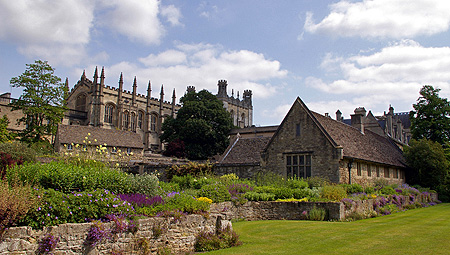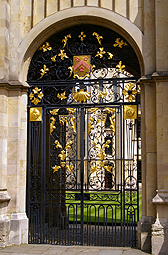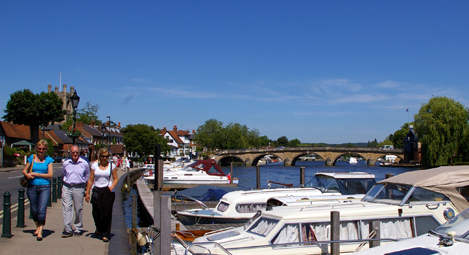Frank's travels around Britain 2009.
Oxford.
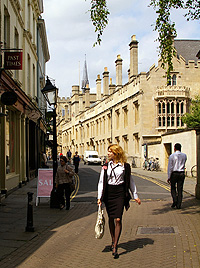 It was 2006 that I last visited Oxford & used it as a base to see the
Cotswolds. As the last time, I was defeated by the difficulty of parking the car! I know it's natural to
compare this city with Cambridge but somehow Oxford struggles to delight me. It
looks like a large town anywhere in Great Britain. Bland outskirts, one way
systems & although it appears to know its going to have tourists, its not
built to take them.
It was 2006 that I last visited Oxford & used it as a base to see the
Cotswolds. As the last time, I was defeated by the difficulty of parking the car! I know it's natural to
compare this city with Cambridge but somehow Oxford struggles to delight me. It
looks like a large town anywhere in Great Britain. Bland outskirts, one way
systems & although it appears to know its going to have tourists, its not
built to take them.
Maybe it's me, but I think if you live there & know what your doing, you're at
a huge advantage.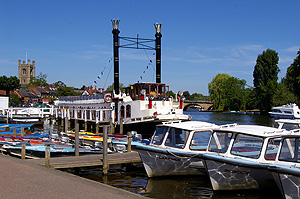
Immediately I arrived, I felt I needed to go away, take a deep breath & work myself back into the city centre. So I went south & started the day in Henley on Thames, just inside the Oxfordshire border.
Henley is a world renowned centre
for rowing, each summer holding the Henley Royal Regatta. The event became Royal
in 1851 when Prince Albert became the patron of the regatta. It is one of the
highlights of the social calendar of the English middle and upper classes & by
God it shows it. It is a beautiful place, there is no lack of money and the
people must pay their rates as all public areas are a joy to use, clean & with
places to park your car. Wide grassy flat banks to laze away your time, moorings
on the Thames & stunning houses with lovely gardens down to the waters edge.
Everything here is "tasteful"! You get the impression they are no Lager
Louts here,
just Hooray Henrys. As I sat on the banks with my ice-cream, a huge motorboat
murmured past, it looked as if it belonged in Monaco. It was crewed by an OAP
couple who looked like they were spending their enormous pension cruising the
Thames in their own personal sunshine. Even amongst the small boats, were what
appeared to be handcrafted wooden structures with stunning brass details. The
river banks were moored with plastic fantastic's, butty boats, tiny hired row boats & even a
pretend
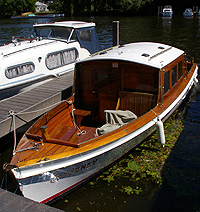 Mississippi paddle steamer! In the town, shopping looked like it was
taken very seriously & a few people looked like their hobby was to display their
wealth by strutting their stuff
as they shopped, but they would never drop. I can see why the celebrities
buy their English homes here but one of the more bizarre facts about this town
is that the icon of eye makeup, Dusty Springfield, has a gravesite and marker in
the grounds of a church in Henley-on-Thames. Her ashes were scattered in Henley
and in Ireland at the Cliffs of Moher. Every year, fans of Dusty Springfield
gather in Henley to celebrate "Dusty Day" on the closest Sunday to her birthday
(16 April).
Mississippi paddle steamer! In the town, shopping looked like it was
taken very seriously & a few people looked like their hobby was to display their
wealth by strutting their stuff
as they shopped, but they would never drop. I can see why the celebrities
buy their English homes here but one of the more bizarre facts about this town
is that the icon of eye makeup, Dusty Springfield, has a gravesite and marker in
the grounds of a church in Henley-on-Thames. Her ashes were scattered in Henley
and in Ireland at the Cliffs of Moher. Every year, fans of Dusty Springfield
gather in Henley to celebrate "Dusty Day" on the closest Sunday to her birthday
(16 April).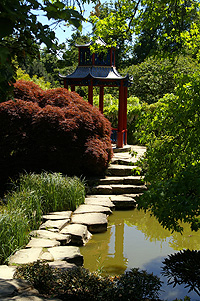
On I
went, in scorching sunshine, to see the gardens of Cliveden just below the M4. The day was hot & the
humidity was high. The poor little Sirion was like a glass house even with the
windows opened. At least I found a few places underneath trees to stop the car &
me from melting. I wonder if the heat helped with the mpg I got? For the first
time I past the magic figure of
60 to the gallon by just keeping it under 3000 revs.
Cliveden is one of those enormous houses, famous for being built by the
incredibly wealthy. The present house, owned by the National Trust and used as a
hotel, was built in 1851 by the architect Charles Barry on the site of a house
built in 1666 as the home of George Villiers, 2nd Duke of Buckingham.
Its history is scattered with names & events. It was let to Frederick, Prince of Wales from 1739 to 1751. It was during this tenure that the song "Rule Britannia" was first performed, in the rustic theatre in the garden in 1740. In 1795 the house was seriously damaged by fire. For the next 30 years it remained a shell; following a second rebuilding it was again destroyed by fire in 1849. I wonder who was strong enough to resist renaming it "Phoenix"?
A great part of it's fame came from it being the home of the Astors. The house became a very fashionable place for prominent figures in both politics and the arts to meet, hunt, stroll in the magnificent gardens, and attend lavish parties. This prominent group of individuals became known as the 'Cliveden Set' and were very influential over the affairs of state. In the mid 1930s the set were accused of calling for the appeasement of Adolf Hitler and Nazi Germany. House records and influential members of the set show that not to be true, and all factions of the political landscape were represented at Cliveden, but the impression of appeasement persists. The house became the centre of the Profumo Affair in 1961, after a chance meeting at a party between cabinet minister John Profumo and showgirl Christine Keeler led to a brief affair, which when made public a year later caused a national security scare as Keeler had also been having an affair with an attaché at the Soviet embassy.
 Everything here is as a result of wealth & influence. Just one instance,
the Clock Tower (water tower) was fully restored in the late 1990s by the NT at
a cost of £650,000 of which at least £35,000 was spent on the gold-leaf
embellishments to the four clock-face surrounds and urns. One of the features of
the gardens is the large collection of sculpture, most of it acquired by the 1st
Lord Astor from 1893 to 1906. Another illustration of wealth is the shell fountain, known as the "Fountain of
Love". It greets visitors at the end of the lime tree avenue up to the house. It
was sculpted by Thomas Waldo Story, (American, 1855–1915) in Rome in 1897 and
was commissioned by Lord Astor for this site. It features a large Carrara marble
shell supporting three life-size female figures attended by cupid. Impressive as
it all is, I was most
attracted by the water gardens, modest by Cliveden standards but quite
beautiful, restful & full of dragonflies.
Everything here is as a result of wealth & influence. Just one instance,
the Clock Tower (water tower) was fully restored in the late 1990s by the NT at
a cost of £650,000 of which at least £35,000 was spent on the gold-leaf
embellishments to the four clock-face surrounds and urns. One of the features of
the gardens is the large collection of sculpture, most of it acquired by the 1st
Lord Astor from 1893 to 1906. Another illustration of wealth is the shell fountain, known as the "Fountain of
Love". It greets visitors at the end of the lime tree avenue up to the house. It
was sculpted by Thomas Waldo Story, (American, 1855–1915) in Rome in 1897 and
was commissioned by Lord Astor for this site. It features a large Carrara marble
shell supporting three life-size female figures attended by cupid. Impressive as
it all is, I was most
attracted by the water gardens, modest by Cliveden standards but quite
beautiful, restful & full of dragonflies.
In the 2004 film Thunderbirds, Cliveden is Lady Penelope's house,
Creighton-Ward Mansion, and FAB1 takes off from the front of the house. I guess
they couldn't find anything more OTT to set off Lady Penelope!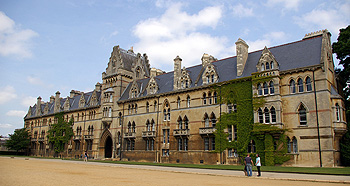
I attempted to go into Oxford that evening as I returned after Cliveden. I never made a car park. I just seemed to wandered around until, with the help of one way streets & bollards I gave up & returned hot, tired & frustrated to a room that cooked me quietly while I failed to sleep. The next day, for the first time on any of my trips, I took the advice of the Travel Lodge staff & used the Park & Ride. Very efficient it was too. Oxford does it's best to stop you using your car & they won too. Maybe the experience put me off. I'm old, cantankerous & want to do it my way at 70. Completely unreasonable, against all common sense but the next time I want to wallow in centre of academia, I'll go back to Cambridge, it suits me better.
 Oxford doesn't seem to have an old part of town that is kept that way, it has
old parts of the town spread out amongst it's modern areas. Shopping high
streets have modern frontages with an odd building thrown in. You turn a corner
that looks like a very unpromising series of shops & there is All Souls college by
the side of Radcliffe Camera, in all
it's glory. Looking at the map, you wonder why they are so randomly scattered.
The truly magnificent Christ Church is down near the river. Surrounded by huge
playing fields & quite isolated unlike other colleges in the centre of town, that bump up against each other's
walls. The University of Oxford is the oldest university in the English-speaking
world. It is also regarded as one of the world's leading academic institutions.
It has 38 independent colleges, and 6 permanent private halls. The university
traces its roots back to at least 1167, although the exact date of foundation
remains unclear, and there is evidence of teaching there as far back as the 10th
century. After a dispute between students and townsfolk broke out in 1209, some
of the academics at Oxford fled north-east to the town of Cambridge, where the
University of Cambridge was founded. The two universities (collectively known as
'Oxbridge') have since had a long history of competition with each other.
Oxford doesn't seem to have an old part of town that is kept that way, it has
old parts of the town spread out amongst it's modern areas. Shopping high
streets have modern frontages with an odd building thrown in. You turn a corner
that looks like a very unpromising series of shops & there is All Souls college by
the side of Radcliffe Camera, in all
it's glory. Looking at the map, you wonder why they are so randomly scattered.
The truly magnificent Christ Church is down near the river. Surrounded by huge
playing fields & quite isolated unlike other colleges in the centre of town, that bump up against each other's
walls. The University of Oxford is the oldest university in the English-speaking
world. It is also regarded as one of the world's leading academic institutions.
It has 38 independent colleges, and 6 permanent private halls. The university
traces its roots back to at least 1167, although the exact date of foundation
remains unclear, and there is evidence of teaching there as far back as the 10th
century. After a dispute between students and townsfolk broke out in 1209, some
of the academics at Oxford fled north-east to the town of Cambridge, where the
University of Cambridge was founded. The two universities (collectively known as
'Oxbridge') have since had a long history of competition with each other.
I must admit, as a man who has an aversion to shopping, Oxford does have one great example of an English shopping experience. It has a very good covered market that supports proper independent shops & is a pleasure to wander around. You would have to walk past it to know its there, but one glance inside & your tempted to stroll through.
The city has every kind of person cheek & jowl. Beggars have their pitches, the herds of Italian school children bump up against Japanese tourists outside the shop dedicated to Alice in Wonderland & "ladies who shop" eat their Panini's & sip their skinny lattes surrounded by their purchases. Threaded through all these are the students. It could have been Founders day or the 3rd after Michaelmas or just something I didn't grasp but there were many dressed in gowns, some carrying their mortar boards but all in black & white, quite a few with a flower in their lapel. It may be a modern Oxford university thing but all their white blouses & white silk ties looked distinctly scruffy & some downright filthy. The crème de la crème of this academic city are proud to look like the students of yesteryear. They are almost a prop from central casting, like the hippies in Glastonbury, showing they are at the top of a tradition that goes back hundreds of years & they are willing to look the part. Even the way they name the weeks of each term is surely unique? I quote "Internally at least, the dates in the term are often referred to by a number in reference to the start of each full term, thus the first week of any full term is called "1st week" and the last is "8th week". The numbering of the weeks continues up to the end of the term, and begins again with negative numbering from the beginning of the succeeding term, through "minus first week" and "noughth week", which precedes "1st week". Weeks begin on a Sunday. Undergraduates must be in residence from Thursday of 0th week." (See how your spell checker copes with "Noughth"!). All around the streets are tourist shops stocked with apparel that says "Oxford University". It is meant to be worn like an American college fraternity's sweater. One thing seems sure, no student here would be caught dead in it!
 It is well known that many television series & films are made in Oxford. On a
trip to see the river & it's boating, I came across a Pub that wasn't opening
because they had a film crew in. No use of toilets, no drinks served even
outside ... but all their staff were in & available! Even the boats were just sat there in this
vaguely unattractive part of the river. The town was full of tourists, it was a
hot sunny day but filming took precedence & it looks like no one got near the river. (I think
it is also a looooong way from the town centre, unlike Cambridge, where the river
is an essential part of the city & colleges ... sorry Oxford, just an opinion!)
It is well known that many television series & films are made in Oxford. On a
trip to see the river & it's boating, I came across a Pub that wasn't opening
because they had a film crew in. No use of toilets, no drinks served even
outside ... but all their staff were in & available! Even the boats were just sat there in this
vaguely unattractive part of the river. The town was full of tourists, it was a
hot sunny day but filming took precedence & it looks like no one got near the river. (I think
it is also a looooong way from the town centre, unlike Cambridge, where the river
is an essential part of the city & colleges ... sorry Oxford, just an opinion!)
Like many other towns, all the staff I met in cafes were foreign & what a nice set of
people they are too. Without exception, they were pleasant, nothing was too much
trouble & no matter how difficult they found English was to master, it was a lot
better than any foreign language I speak. Whichever country they came from,
they were all fine ambassadors.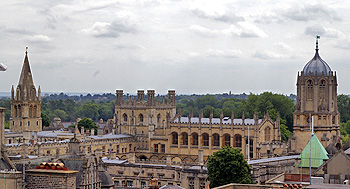
I climbed to the top of Carfax Tower which is located at the conjunction of St Aldate's (south), Cornmarket Street (north), Queen Street (west) and the High Street (east) & is considered to be the centre of the city. The name "Carfax" derives from the French "carrefour", or "crossroads". The Tower is all that remains of the 13th century St Martin's Church and is now owned by the Oxford City Council. It is 23 m (74 ft) tall and still contains a ring of six bells, recast from the original five by Richard Keene of Woodstock in 1676. These chime the quarter hours and are rung on special occasions by the Oxford Society of Change Ringers.
Oxford is known as the "city of dreaming spires", a term coined by poet Matthew Arnold in reference to the harmonious architecture of Oxford's university buildings. I guess I don't have his eye for beauty now. It is possible to get good photographs at this height but in reality, you see what a jumble the city is. It's all there, the old & ancient with spires pop up but the modern is scattered everywhere.
